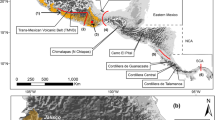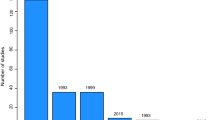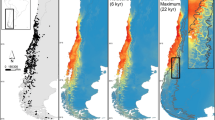Abstract
Recent studies have improved our understanding of Amazonian geological history during the late Tertiary and Quaternary, two periods regarded as critical for the recent diversification of the Amazonian avifauna. The notion that geologically older and more stable areas of Amazonia (such as the Brazilian and Guianan shields) functioned as “species-pumps”, whereas geologically more dynamic areas (such as the western Amazonian lowlands) mostly “captured” part of the diversity generated nearby, was supported by a recent phylogeographic study focusing on a species complex of the genus Xiphorhynchus (Dendrocolaptidae). Here, we review several additional molecular datasets to assess whether this historical scenario can be extended to other lineages of Amazonian birds as well. The datasets reviewed indicated that most lineages of upland forest species found nowadays in western Amazonia are associated with more basal lineages from the Brazilian shield, Guianan shield, and the Andes, indicating a more recent history in this geologically dynamic region. Conversely, lineages associated with seasonally flooded forests seem to have an ancient history in western Amazonia, apparently expanding over the geologically more stable areas only recently. Most sister taxa of the lineages reviewed exhibited levels of pairwise sequence divergence consistent with splitting events dating back to a time frame stretching from the late Miocene to the early Pleistocene, a period when significant physiographic and landscape changes took place in Amazonia. When interpreted together, all the studies reviewed provide evidence that geology and landscape evolution are tightly linked with the timing and mode of differentiation of Amazonian birds.


Similar content being viewed by others
References
Aleixo A (2002) Molecular systematics and the role of the “várzea”-”terra-firme” ecotone in the diversification of Xiphorhynchus woodcreepers (Aves: Dendrocolaptidae). Auk 119:621–640
Aleixo A (2004) Historical diversification of a “terra-firme” forest bird superspecies: a phylogeographic perspective on the role of different hypotheses of Amazonian diversification. Evolution 58:1303–1317
Aleixo A (2006) Historical diversification of floodplain forest specialist species in the Amazon: a case study with two species of the avian genus Xiphorhynchus (Aves: Dendrocolaptidae). Biol J Linn Soc 89:383–395
Aleixo A, Burlamaqui T, Gonçalves EC, Schneider MPC (2006) Molecular systematics of the ocellated woodcreeper complex (Dendrocolaptidae) in tropical South America: implications for taxonomy, conservation, and historical biogeography. J Ornithol 147 [Suppl 1]:125–126
Armenta JK, Weckstein JD, Lane DF (2005) Geographic variation in mitochondrial DNA sequences of an Amazonian non-passerine: the black-spotted barbet complex. Condor 107:527–536
Bates JM (2001) Avian diversification in Amazonia: evidence for historical complexity and a vicariance model for a basic pattern of diversification. In: Vieira I, D’Incão MA, Silva JMC, Oren D (eds) Diversidade biológica e cultural da Amazônia. Museu Paraense Emílio Goeldi, Belem, pp 119–138
Bates JM, Hackett SJ, Goerck JM (1999) High levels of mitochondrial DNA differentiation in two lineages of antbirds (Drymophila and Hypocnemis). Auk 116:1093–1106
Behling H, Costa ML (2000) Holocene environmental changes from the Rio Curuá record in the Caxiuanã region, Eastern Amazon Basin. Quat Res 53:369–377
Burns KJ, Naoki K (2004) Molecular phylogenetics and biogeography of neotropical tanagers in the genus Tangara. Mol Phylogenet Evol 32:838–854
Bush MB (1994) Amazonian speciation: a necessarily complex model. J Biogeogr 21:5–17
Campbell KE (1990) The geologic basics of biogeographic patterns in Amazonia. In: Peters G, Hutterer R (eds) Vertebrates in the tropics. Museum Alexander Koenig, Bonn pp 33–43
Campbell KE, Heizler M, Frailey CD, Romero-Pittman L, Prothero DR (2001) Upper Cenozoic chronostratigraphy of the southwestern Amazon basin. Geology 29:595–598
Campbell KE, Frailey CD, Romero-Pittman L (2006) The Pan-Amazonian Ucayali Peneplain, late Neogene sedimentation in Amazonia, and the birth of the modern Amazon river system. Palaeo 239:166–219
Cheviron ZA, Hackett SJ, Capparella AP (2005) Complex evolutionary history of a Neotropical lowland forest bird (Lepidothrix coronata) and its implications for historical hypotheses of the origin of Neotropical avian diversity. Mol Phylogenet Evol 36:338–357
Colinvaux PA (1993) Pleistocene biogeography and diversity in tropical forests of South America. In: GoldBlatt P (ed) Biological relationships between Africa and South America. Yale University Press, New Haven pp 473–499
Costa JBS, Hasui Y (1997) Evolução geológica da Amazônia. In: Costa ML, Angélica RS (eds) Contribuições à Geologia da Amazônia. Sociedade Brasileira de Geologia, Belem pp 15–19
Eberhard JR, Bermingham E (2005) Phylogeny and comparative biogeography of Pionopsitta parrots and Pteroglossus toucans. Mol Phylogenet Evol 36:288–304
Endler JA (1977) Geographic variation, speciation, and clines. Princeton University Press, Princeton
Endler JA (1982) Pleistocene forest refuges: fact or fancy? In: Prance GT (ed) Biological diversification in the tropics. Columbia University Press, New York pp 641–657
Garcia-Moreno J (2004) Is there a universal mtDNA clock for birds? J Avian Biol 35:465–468
Gascon C, Malcolm JR, Patton JL, Silva MNF, Bogart JP, Lougheed SC, Peres CA, Neckel S, Boag PT (2000) Riverine barriers and the geographic distribution of Amazonian species. Proc Natl Acad Sci U S A 97:13672–13677
Grau ET, Pereira SL, Silveira LF, Höfling E, Wajntal A (2005) Molecular phylogenetics and biogeography of Neotropical piping guans (Aves: Galliformes): Pipile Bonaparte, 1856 is synonym of Aburria Reichenbach, 1853. Mol Phylogenet Evol 35:637–645
Haffer J (1969) Speciation in Amazonian forest birds. Science 165:131–137
Haffer J (1974) Avian speciation in tropical South America. Nuttall Ornithological Club, Cambridge
Haffer J (1993) Time’s cycle and time’s arrow in the history of Amazonia. Biogeographica 69:15–45
Haffer J, Prance GT (2001) Climatic forcing of evolution in Amazonia during the Cenozoic: on the refuge theory of biotic differentiation. Amazoniana 16:579–607
Hall JPW, Harvey DJ (2002) The phylogeography of Amazonia revisited: new evidence from Riodinid butterflies. Evolution 56:1489–1497
Harrison R (1991) Molecular changes at speciation. Ann Rev Ecol Syst 22:281–308
Hoorn C (1994a) Miocene palynostratigraphy and paleoenvironments of northwestern Amazonia. PhD thesis, University of Amsterdam, Amsterdam
Hoorn C (1994b) An environmental reconstruction of the palaeo-Amazon river system (Middle–Late Miocene, NW Amazonia). Palaeo 112:187–238
Hoorn C, Guerrero J, Sarmiento GA, Lorente MA (1995) Andean tectonics as a cause for changing drainage patterns in Miocene northern South America. Geology 23:237–240
Irion G (1984) Sedimentation and sediments of Amazonian rivers and evolution of the Amazonian landscape since Pliocene times. In: Sioli H (ed) The Amazon limnology and landscape ecology of a mighty tropical river and its basin. Junk, Dordrecht, pp 201–214
Irion G, Muller J, Mello JN, Junk WJ (1995) Quaternary geology of the Amazonian lowland. Geo Mar Lett 15:267–309
Klicka J, Zink RM (1997) The importance of ice ages in speciation: a failed paradigm. Science 277:1666–1669
Lougheed SC, Gascon C, Jones DA, Bogart JP, Boag PT (1999) Ridges and rivers: a test of competing hypotheses of Amazonian diversification using a dart-poison frog (Epipedobates femoralis). Proc R Soc Lond B Biol Sci 266:1829–1835
Lovette IJ (2004a) Mitochondrial dating and mixed support for the “2% rule” in birds. Auk 121:1–6
Lovette IJ (2004b) Molecular phylogeny and plumage signal evolution in a trans Andean and circum Amazonian avian species complex. Mol Phylogenet Evol 32:512–523
Lundberg JG, Marshall LG, Guerrero J, Horton B, Malabarba MCSL, Wesselingh F (1998) The stage for Neotropical fish diversification: a history of tropical South American rivers. In: Malabarba LR, Reis RE, Vari RP, Lucena ZMS, Lucena CAS (eds) Phylogeny and classification of Neotropical fishes. EDIPUCRS, Porto Alegre, pp 13–48
Marantz C, Aleixo A, Bevier LR, Patten MA (2003) Family Dendrocolaptidae (woodcreepers). In: del Hoyo J, Elliott A, Christie D (eds) Handbook of the birds of the world, vol 8. Broadbills to tapaculos. Lynx Edicions, Barcelona, pp 358–447
Marks BD, Hackett SJ, Capparella AP (2002) Historical relationships among Neotropical lowland forest areas of endemism as determined by mitochondrial DNA sequence variation within the wedge-billed woodcreeper (Aves: Dendrocolaptidae: Glyphorynchus spirurus). Mol Phylogenet Evol 24:153–167
Marroig G, Cerqueira R (1997) Plio–Pleistocene South American history and the Amazon lagoon hypothesis: a piece of the puzzle of Amazonian diversification. J Comp Biol 2:103–119
Mittermeier RA, Mittermeier CG, Brooks TM, Pilgrim JD, Konstant WR, da Fonseca GAB, Kormos C (2003) Wilderness and biodiversity conservation. Proc Natl Acad Sci U S A 100:10309–10313
Moritz C, Patton JL, Schneider CJ, Smith TB (2000) Diversification of rainforest faunas: an integrated molecular approach. Ann Rev Ecol Syst 31:533–563
Nuttall CP (1990) A review of the Tertiary non-marine molluscan faunas of the Pebasian and other inland basins of north-western South America. Bull Br Mus Nat Hist Geol 45:165–371
Oliveira AI, Leonardos OH (1943) Geologia do Brasil, 2nd edn. Serviço de Informação Agrícola, Rio de Janeiro
Patton JL, Silva MNF (1998) Rivers, refuges, and ridges: the geography of speciation of Amazonian mammals. In: Howard DJ, Berlocher SH (eds) Endless forms: species and speciation. Oxford University Press, Oxford, pp 202–213
Patton JL, Silva MNF, Malcolm JR (1994) Gene genealogy and differentiation among arboreal spiny rats (Rodentia: Echmyidae) of the Amazon: a test of the riverine barrier hypothesis. Evolution 48:1314–1323
Patton JL, Silva MNF, Malcolm JR (1996) Hierarchical genetic structure and gene flow in three sympatric species of Amazonian rodents. Mol Ecol 5:229–238
Patton JL, Silva MNF, Malcolm JR (2000) Mammals of the Rio Juruá and the evolutionary and ecological diversification of Amazonia. Bull Am Mus Nat Hist 244:1–306
Pereira SL, Baker AJ (2004) Vicariant speciation of curassows (Aves, Cracidae): a hypothesis base on mitochondrial DNA phylogeny. Auk 121:682–694
Räsänen ME, Salo JS, Kalliola RJ (1987) Fluvial perturbance in the western Amazon basin: regulation by long-term sub-Andean tectonics. Science 238:1398–1401
Räsänen ME, Salo JS, Jungner H, Romero-Pittman L (1990) Evolution of the western Amazon lowland relief: impact of Andean foreland dynamics. Terra Nova 2:320–332
Räsänen ME, Linna AM, Santos JCR, Negri FR (1995) Late Miocene tidal deposits in the Amazonian foreland basin. Science 269:386–390
Ribas CC, Miyaki CY (2004) Molecular systematics in Aratinga parakeets: species limits and historical biogeography in the “solstitialis” group, and the systematic position of Nandayus nenday. Mol Phylogenet Evol 30:663–675
Ribas CC, Gaban-Lima R, Miyaki CY, Cracraft J (2005) Historical biogeography and diversification within the Neotropical Parrot genus Pionopsitta (Aves: Psittacidae). J Biogeogr 32:1409–1427
Ribas CC, Joseph L, Miyaki CY (2006) Molecular systematics and patterns of diversification in Pyrrhura (Psittacidae), with special reference to the picta–leucotis complex. Auk 123:660–680
Rossetti DF, Toledo PM, Góes AM (2005) New geological framework for Western Amazonia (Brazil) and implications for biogeography and evolution. Quat Res 63:78–89
Roy MS, Silva JMC, Arctander P, Garcia-Moreno J, Fjeldså J (1997) The speciation of South American and African birds in montane regions. In: Mindell D (ed) Avian molecular evolution and systematics. Academic, London, pp 325–343
Rüegg W, Rosenzweig A (1949) Contribución a la geología de las formaciones modernas de Iquitos y de la Amazonia Superior. Bol Soc Geol Peru 3:1–24
Silva MNF, Patton JL (1998) Molecular phylogeography and the evolution and conservation of Amazonian mammals. Mol Ecol 7:475–486
Silva JMC, Rylands AB, Silva JS Jr, Gascon G, Fonseca GAB (2005) Primate diversity patterns and their conservation in Amazonia. In: Purvis A, Gittleman JL, Brooks T (eds) Phylogeny and conservation. Cambridge University Press, Cambridge, pp 337–364
Stotz DF, Fitzpatrick JW, Parker TA III, Moskovits DB (1996) Neotropical birds: ecology and conservation. University of Chicago Press, Chicago
Symula R, Chulte R, Summers K (2003) Molecular systematics and phylogeography of Amazonian poison frogs of the genus Dendrobates. Mol Phylogenet Evol 26:452–475
Van Tuinen M, Hadly EA (2004) Error in estimation of rate and time inferred from the early amniote fossil record and avian molecular clocks. J Mol Evol 59:267–276
Vonhof HB, Wesslingh FP, Ganssen GM (1998) Reconstruction of the Miocene western Amazonian aquatic system using molluscan isotopic signatures. Palaeo 141:239–293
Wallace AR (1852) On the monkeys of the Amazon. Proc Zool Soc Lond 20:107–110
Weir JT (2006) Divergent timing and patterns of species accumulation in lowland and highland Neotropical birds. Evolution 60:842–855
Weckstein JD (2005) Molecular phylogenetics of the Ramphastos toucans: implications for the evolution of morphology, vocalizations, and coloration. Auk 122:1191–1209
Wesselingh FP, Räsänen ME, Irion G, Vonhof HB, Kaandorp R, Renema W, Romero-Pittman L, Gingras M (2001) Lake Pebas: a palaeoecological reconstruction of a Miocene long-lived lake complex in western Amazonia. Cainoz Res 1:35–81
Acknowledgments
A. Aleixo attended the 24th International Ornithological Congress (IOC) in Hamburg thanks to funds granted by CNPq (The National Research Council of Brazil, grant no. 45.2485/2006-1) and the 24th IOC committee; his studies in Brazil are partially funded by the a joint CNPq/SECTAM research grant (no. 35.0415/2004-8). He also thanks J. Bates, C. Miyaki, C. Ribas, and J. Tello for insightful and stimulating discussions on the data and patterns discussed here. D. Rossetti thanks FAPESP (project no. 004/15518-6) for financial support that has contributed to part of the research presented here; she also holds a scholarship from CNPq. We thank two anonymous referees for insightful comments and suggestions on an earlier version of the manuscript.
Author information
Authors and Affiliations
Corresponding author
Additional information
Communicated by C. Rahbeck.
Rights and permissions
About this article
Cite this article
Aleixo, A., Rossetti, D.d. Avian gene trees, landscape evolution, and geology: towards a modern synthesis of Amazonian historical biogeography?. J Ornithol 148 (Suppl 2), 443–453 (2007). https://doi.org/10.1007/s10336-007-0168-7
Received:
Revised:
Accepted:
Published:
Issue Date:
DOI: https://doi.org/10.1007/s10336-007-0168-7




